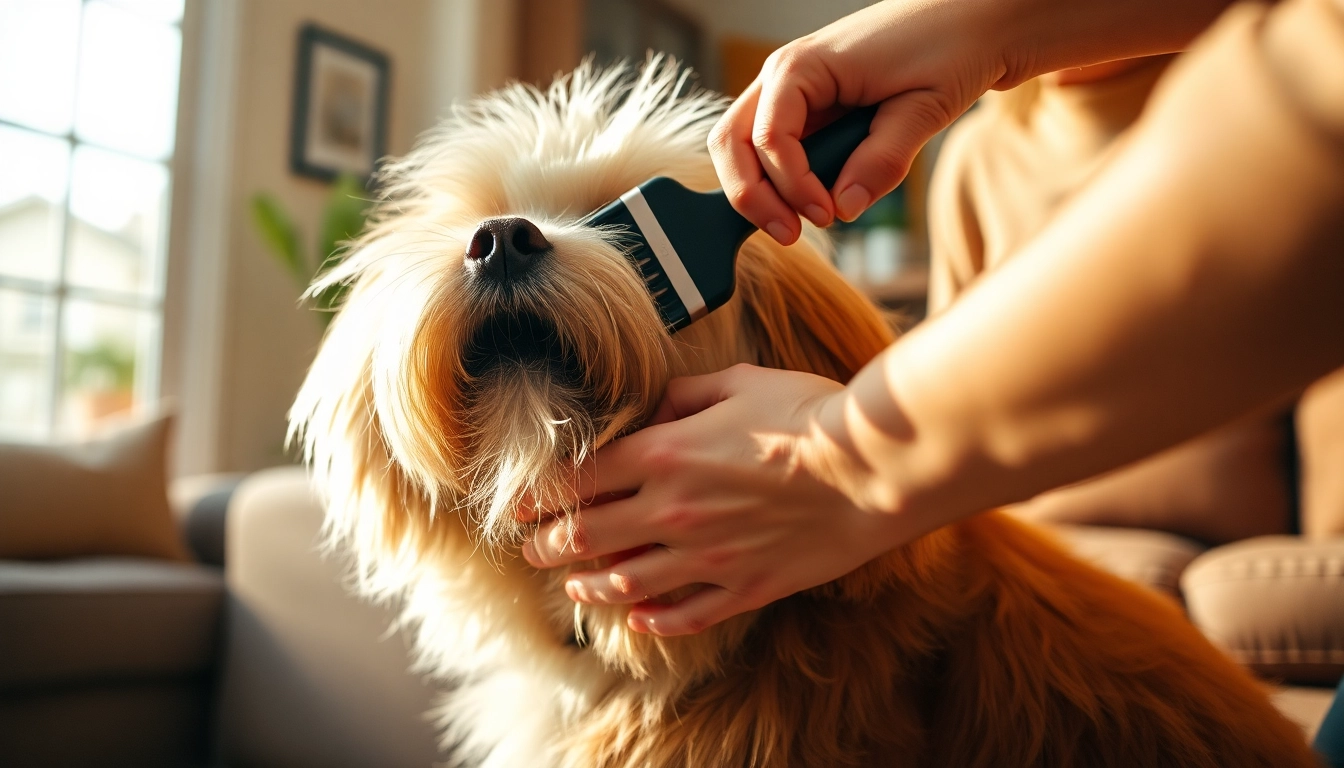Understanding Pet Hair Brushes
What is a Pet Hair Brush?
A pet hair brush is a specialized grooming tool designed to remove loose fur, dirt, and debris from your pet’s coat. It helps in keeping your pet’s fur healthy and tangle-free, while also reducing shedding in your home. Using a pet hair brush can be a fundamental part of your dog’s grooming routine, ensuring they remain comfortable and look their best.
Types of Pet Hair Brushes Available
Pet hair brushes come in various types designed for different fur types and grooming needs. Understanding these can help you select the right brush for your dog:
- Slicker Brushes: These brushes have fine, short wires close together, making them effective in removing tangles and mats.
- Paddle Brushes: Commonly used for medium to long-haired dogs, paddle brushes offer a wide head to cover more surface area while grooming.
- Pin Brushes: Featuring plastic or metal pins, these brushes are great for fluffing up your dog’s coat and removing loose fur.
- Undercoat Rakes: Perfect for double-coated dogs, undercoat rakes target the dense undercoat without damaging the top coat.
- Bristle Brushes: Suitable for short-haired breeds, these brushes help distribute natural oils and keep the coat shiny.
How to Choose the Right Brush for Your Dog
Choosing the right brush for your dog depends on several factors, including coat type, length, and grooming needs. Here’s how you can make the best choice:
- Coat Type: Consider whether your dog has short, medium, or long hair.
- Specific Needs: If your dog is prone to matting, invest in a slicker brush or undercoat rake.
- Size of Your Dog: Ensure the brush size is appropriate for your dog’s size.
- Comfort: Check that the handle is ergonomic and that the brush is comfortable for you to use during longer grooming sessions.
Benefits of Regular Grooming with a Pet Hair Brush
Reducing Shedding and Allergens
Regular grooming significantly reduces shedding, helping keep your home cleaner and minimizing allergens in your living space. By removing loose hair that would otherwise contribute to dust and dander, a pet hair brush can be a game-changer for allergy sufferers in the household.
Improving Overall Coat Health
Using the right pet hair brush regularly not only removes loose hair but also encourages healthy blood circulation and the distribution of natural oils across the coat. This leads to a shinier, healthier appearance, and can prevent skin issues that arise from matting and neglect.
Enhancing the Bond with Your Pet
Grooming your dog is more than just a maintenance task; it’s an opportunity to bond. Taking the time to groom your pet fosters trust and comfort, creating a stronger relationship between you and your furry friend.
Techniques for Effective Grooming
Best Practices for Using a Pet Hair Brush
To maximize the benefits of your grooming sessions, adhere to these best practices:
- Brush in the Direction of Hair Growth: Always brush in the direction your pet’s hair grows to avoid discomfort.
- Be Gentle: Use a light hand, especially on sensitive areas like the belly and face.
- Watch for Mats: If you encounter mats, don’t pull—use a detangling spray or go over them gently with a slicker brush.
Grooming Tips for Different Dog Breeds
Different breeds come with unique grooming requirements. Here are tailored tips:
- Long-Haired Breeds (e.g., Collies, Shih Tzus): Frequent grooming with slicker brushes can prevent tangles.
- Short-Haired Breeds (e.g., Beagles, Boxers): Use bristle brushes or rubber grooming mitts to remove loose hair effectively.
- Curly-Coated Breeds (e.g., Poodles, Bichons): Regularly use a pin brush to keep the curls defined and healthy.
Frequency of Grooming Sessions
The frequency of grooming will vary depending on your dog’s breed, coat type, and activity level. As a general rule:
- Short-haired dogs: Once a week.
- Medium-haired dogs: Every 1-2 weeks.
- Long-haired dogs: Several times a week, depending on matting.
Choosing Quality Pet Hair Brushes
Features to Look for in a Pet Hair Brush
Not all pet hair brushes are created equal. When selecting one, consider the following features:
- Ergonomic Handle: A comfortable grip is essential for effective grooming without hand fatigue.
- Durable Bristles: Ensure the bristles are sturdy enough to withstand regular use without falling out or becoming bent.
- Ease of Cleaning: Look for brushes that can be easily cleaned to maintain hygiene and efficacy.
Comparing Materials and Durability
Understanding the materials of a pet hair brush can help in gauging its durability:
- Plastic: Lightweight and affordable but can wear out faster than other materials.
- Rubber: Flexible and gentle on the dog’s skin, often provides a massaging action.
- Stainless Steel: Durable and resistant to rust, making them suitable for long-term use.
Brand Recommendations and Reviews
When investing in a pet hair brush, consider brands known for their quality. Some of the best-reviewed brands include:
- FURminator: Renowned for its de-shedding tools.
- Hertzko: Offers ergonomic designs for easy grooming.
- Slicker Brush: Trusted in the grooming community for its effective detangling capabilities.
Troubleshooting Grooming Challenges
Dealing with Tangled Fur
Finding mats and tangles can be frustrating, but there are ways to manage them effectively:
- Use Detangling Spray: This can make it easier to work through knots without pulling.
- Take Your Time: Be patient; rushing can cause pain to your pet and may worsen the situation.
- Work from the Bottom Up: Start detangling from the ends of the fur and gradually move up to the root.
Managing a Pet’s Grooming Anxiety
If your dog becomes anxious during grooming, consider these strategies:
- Introduce the Brush Gradually: Allow your dog to sniff and explore the brush without using it immediately.
- Break It Down: Start with short grooming sessions and gradually increase the duration.
- Reward System: Use treats and praise to create positive associations with grooming.
When to Seek Professional Grooming Services
While regular at-home grooming is vital, certain situations may require professional assistance:
- Severe matting that you cannot manage at home.
- If your dog requires specialized grooming techniques that you are not comfortable with.
- For certain breeds, regular grooming can be a necessity; professional groomers have the expertise and tools for proper care.



